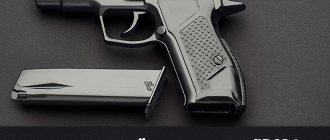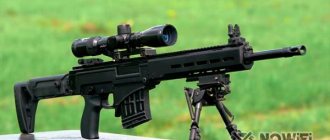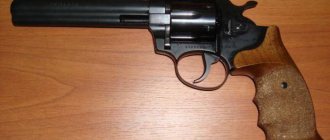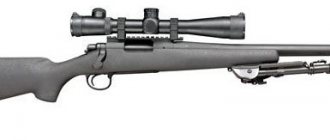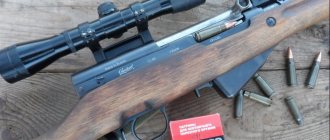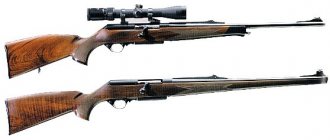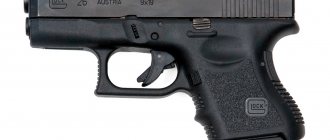Distinctive features
Among all the models, this one was the first to use the .40 S&W cartridge. The purpose of creating this pistol was to increase shooting efficiency. The creators of the weapon achieved this achievement by using a cartridge characterized by a higher stopping power of the bullet compared to the same 9mm Parabellum.
At the same time, the dimensions and weight of the pistol remained the same as that of the Model 17. The .40 S&W cartridge, in terms of characteristics such as the stopping effect of the bullet and the width of the cartridge case, can be considered as an intermediate option between the 9mm Parabellum and .45 ACP. It ideally combines parameters such as dimensions and shooting efficiency. Pistols with double-stack magazines chambered in .40 S&W have a distinct advantage over their counterparts chambered in .45 ACP. First of all, this relates to width, so when carried concealed they are less noticeable, more comfortable and less burdensome.
Options
Glock 23 4
is a pistol of the fourth production generation, contains the following differences:
- The handle as standard has an RTF design, but compared to the RTF2 of third-generation pistols, there are larger gaps between the dots - 25 dots per cm², instead of 64 for the RTF, and the dots themselves are larger.
- The back of the handle is a separate, replaceable part called the back strap. The minimum size part SF (short frame) is installed as standard. The gun comes with two additional parts M (medium) and L (large), which can be installed instead of the standard one. Part M increases the distance to the trigger by 2 mm, L - by 4 mm. Thus, they provide improved grip ergonomics for shooters with longer fingers. To change the part, you need to remove the fastening pin, for which a special tool is provided in the kit.
- The magazine release button has become larger and more convenient. It also became possible to move it to the right side (more convenient for left-handed shooters). In this regard, on magazines of fourth-generation pistols, a second window appeared for the latch tooth, on the right side. Magazines from previous generation pistols can be used in fourth generation pistols, but only if the button is installed on the left.
- Instead of one return spring, the fourth generation pistols began to install two springs of different diameters (on one guide rod). In this case, the load arising during recoil is distributed more evenly, the survivability of each individual spring increases, and the recoil felt by the shooter is reduced.
- Unlike previous generations, the fourth has the corresponding marking on the slide - Glock 23 Gen4.
Weapon Information
The Glock 22 Gen 4 .40 pistol features a modular backstrap design that allows it to be adjusted to fit your hand size without changing your grip angle. It also has a Safe Action system, which consists of three independent automatic safety measures that help prevent unintentional discharge. The barrel of the pistol is made using the cold forging method, the weapon itself has a reinforced polymer frame with Gen 4 texturing technology. Equipped with an auxiliary rail.
The Glock 22 is based on the same mid-sized frame as the G 17 9mm and has only 34 components, demonstrating the simplicity of the design. The pistol also features Glock's legendary safety action system.
The pistol grip is thin. The Gen 4 grip frame is modular, with interchangeable ribs that can be swapped out to fit each user's hand size. New, rough, streamlined texture on the front, back and sides of the handle provides increased control. Inside there is a new double (concentric) spring system that increases the life of the gun. Another improvement is a larger, ambidextrous magazine release that can be switched in seconds to the other side of the frame for left-handed shooting.
Variants
Glock 31 Standard model. Glock 31C Standard model with compensating barrel. Glock 32 Compact model. Glock 33 Subcompact model.
| Glock Products |
| Firearms |
| Pistols |
| Equipment |
| Entrenching Tools |
| Field Knives |
| Weapons of Austria Modern Period (1946 - Present) |
| Infantry Weapons | ||
| Melee Weapons | Bayonet | ] |
| Survival Weapons | ] | |
| Sidearms | Pistol | |
| Revolver | ] | |
| Machine Pistol | ] | |
| Close Quarters | Personal Defense Weapons | ] |
| Submachine Gun | TMP | |
| Shotgun (automatic) | ] | |
| Shotgun (semi-automatic) | ] | |
| Shotgun (manual-action) | ] | |
| Primary Weapons | Assault Rifle (5.45/5.56) | ACR • AUG • STM 556 |
| Assault Rifle (7.62) | ] | |
| Assault Rifle (other) | ] | |
| Carbine (5.45/5.56) | ] | |
| Carbine (7.62) | ] | |
| Carbine (other) | ] | |
| Automatic Support Weapons | Light Machine Gun | ] |
| General Purpose Machine Gun | ] | |
| Heavy Machine Gun | ] | |
| Long Range | Anti-Material Rifle | ] |
| Bolt-Action Rifle | ] | |
| Designated Marksman Rifle | ] | |
| Launchers | Grenade Launcher (Attachment) | ] |
| Grenade Launcher (Standalone) | ] | |
| Disposable Rocket Launcher | ] | |
| Rocket Launcher | ] | |
| Guided, Anti-Tank | ] | |
| Guided, Anti-Air | ] | |
| Non-Lethal Weapons | Rifle | ] |
| Pistol | ] | |
| Underwater Weapons | Sidearm | ] |
| Rifle | ] | |
| Explosives | Anti-Personnel Mines | ] |
| Anti-Tank Mines | ] | |
| Offensive Grenades | ] | |
| Smoke Grenades | ] |
| Firearm Accessories | ||
| Optics | Iron Sights | ] |
| Collimator | ] | |
| Telescopic | ] | |
| Magnifier | ] | |
| Attachments | Flashlights & Lasers | ] |
| Foregrips & Bipods | ] |
| Infantry Equipment | ||
| Clothes | Backpacks | ] |
| Body Armor | ] | |
| Bomb Suit | ] | |
| Elbow and knee pads | ] | |
| Signals & IFF | ] | |
| Suits | ] | |
| Vests & Webbing | ] | |
| Headwear | Communication | ] |
| Gas Masks & Rebreathers | ] | |
| Goggles | ] | |
| Helmets | ] | |
| Vehicle Headwear | ] | |
| Optics, Detection and Surveillance | Man-Portable Radar | ] |
| Mine Detectors | ] | |
| Night Vision Goggles | ] | |
| Periscopes | ] | |
| Rangefinders | ] | |
| Surveillance | ] |
| Artillery | |
| Anti-Aircraft Guns | ] |
| Anti-Tank Guns | ] |
| Anti-Tank Guided Missiles | ] |
| Anti-Tank Guided Missile Systems | ] |
| Anti-Tank Guided Missile Systems | ] |
| Howitzers | ] |
| Mortars | ] |
| Railroad Artillery | ] |
| Recoilless Guns | ] |
| Rocket Artillery | ] |
| Siege Artillery | ] |
| Land Vehicle Weapons | |
| Vehicle Machine Guns | ] |
| 57mm Tank Guns | ] |
| 73mm Tank Guns | ] |
| 76.2mm Tank Guns | ] |
| 85mm Tank Guns | ] |
| 100mm Tank Guns | ] |
| 115mm Tank Guns | ] |
| 120mm Tank Guns | ] |
| 122mm Tank Guns | ] |
| 125mm Tank Guns | ] |
| 130mm Tank Guns | ] |
| 152.4mm Tank Guns | ] |
| Heavy Guns | ] |
| Vehicle Autocannon | ] |
| Aircraft Weapons & Munitions | |
| 7.62mm Machine Guns | ] |
| 12.7mm Machine Guns | ] |
| 23mm Cannons | ] |
| 30mm Cannons | ] |
| 37mm Cannons | ] |
| Rocket Pods | ] |
| Rockets | ] |
| Air-to-Air Missiles | ] |
| Air-to-Ship Missiles | ] |
| Air-to-Surface Missiles | ] |
| Anti-Radiation Missiles | ] |
| Cruise Missiles | ] |
| Bombs | ] |
Pistol r-411 and its characteristics
Characteristics
Distinctive features:
- Trigger pull: 5.5 pounds or 2.5 kg.
- Adapted for shooting with both right and left hands.
- Barrel length: 4.49 inches or 11.4 cm.
- Double action trigger mechanism.
- Ammunition type: centerfire cartridge.
- Caliber: .40.
- Polygonal cutting of the barrel.
- Weight: 22.75 ounces or 645 grams (without magazine); 34.29 ounces, or 972 grams (with magazine).
- Overall length: 7.95 inches or 20.2 cm. Height 5.43 inches (13.8 cm), width 1.18 inches (3 cm).
- Magazine capacity: 15 rounds.
Features and Benefits:
- Reinforced polymer frame with Gen 4 texturing technology.
- The accessory rail allows for modular installation of removable parts.
- Equipped with a double return spring.
Not only does the durable polymer frame weigh less, it's also stronger than most metals, requires little maintenance and reduces recoil. The barrel is positioned much closer to the top of the hand, which directs the recoil impulse to travel straight back rather than down and up. The polymer frame makes it nearly impervious to rust and corrosion.
The Glock 22's built-in rail provides plenty of room to mount lasers like the Viridian C5.
Options
Glock 23 4
- a pistol of the fourth production generation, contains the following differences:
- The handle as standard has an RTF design, but compared to the RTF2 of third-generation pistols, there are larger gaps between the dots - 25 dots per cm², instead of 64 for the RTF, and the dots themselves are larger.
- The back of the handle is a separate, replaceable part called the back strap. The minimum size part SF (short frame) is installed as standard. The gun comes with two additional parts M (medium) and L (large), which can be installed instead of the standard one. Part M increases the distance to the trigger by 2 mm, L - by 4 mm. Thus, they provide improved grip ergonomics for shooters with longer fingers. To change the part, you need to remove the fastening pin, for which a special tool is provided in the kit.
- The magazine release button has become larger and more convenient. It also became possible to move it to the right side (more convenient for left-handed shooters). In this regard, on magazines of fourth-generation pistols, a second window appeared for the latch tooth, on the right side. Magazines from previous generation pistols can be used in fourth generation pistols, but only if the button is installed on the left.
- Instead of one return spring, the fourth generation pistols began to install two springs of different diameters (on one guide rod). In this case, the load arising during recoil is distributed more evenly, the survivability of each individual spring increases, and the recoil felt by the shooter is reduced.
- Unlike previous generations, the fourth has the corresponding marking on the slide - Glock 23 Gen4.
Ease of maintenance
This gun is easy to operate and maintain and does not require additional fine tuning. Another advantage is the ease of disassembly of the Glock 22 pistol. The only place where caution is required is to ensure that the pistol is unloaded before beginning the disassembly process. This is because the first step in the process is pulling the trigger, and unfortunately, some careless and/or improperly trained individuals have been victims of accidental discharges while a round was left in the loading chamber. Once the cartridge is removed from the chamber, the magazine is removed, then the hammer is removed, after which the handle latch can be manipulated, the slide retracted as far as necessary and pulled forward out of the frame. After this, the recoil ejector spring is removed, and then the barrel. These steps are sufficient for routine cleaning of the gun.
Design
The Glock 23 has the same design as other Glock pistols (with the exception of the Glock 25 and Glock 28 pistols, which use a different automatic operating principle - the blowback principle). The automatic operation of the pistol operates on the principle of using recoil during a short stroke of the barrel; the bolt is unlocked when the barrel is skewed in a vertical plane due to the interaction of a figured groove in the lug of the breech of the barrel with the body of the pistol. Locking is accomplished by inserting the rectangular breech of the barrel into the window for ejecting cartridges. The trigger mechanism is striker-fired, with partial cocking and additional cocking with each shot. There are three automatic safeties: a trigger safety locks the rearward movement of the hook, releasing it only when the trigger itself is pressed directly; one firing pin safety makes it impossible to fire when the firing pin is released, the second blocks the firing pin until the trigger is pulled; the pistol does not have manual safeties. The pistol frame is made of polymer material.
Design
The Glock 23 has the same design as other Glock pistols (with the exception of the Glock 25 and Glock 28 pistols, which use a different automatic operating principle - the blowback principle). The automatic operation of the pistol operates on the principle of using recoil during a short stroke of the barrel; the bolt is unlocked when the barrel is skewed in a vertical plane due to the interaction of a figured groove in the lug of the breech of the barrel with the body of the pistol. Locking is accomplished by inserting the rectangular breech of the barrel into the window for ejecting cartridges. The trigger mechanism is striker-fired, with partial cocking and additional cocking with each shot. There are three automatic safeties: a trigger safety locks the rearward movement of the hook, releasing it only when the trigger itself is pressed directly; one firing pin safety makes it impossible to fire when the firing pin is released, the second blocks the firing pin until the trigger is pulled; the pistol does not have manual safeties. The pistol frame is made of polymer material.

